Nvidia GeForce GTX 1080 Ti Founders Edition, Unboxed
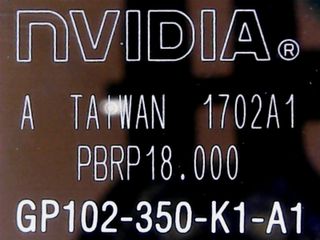
At an event during the Games Developers Conference (GDC) in San Francisco, Nvidia CEO Jen-Hsun Huang introduced the Nvidia GeForce GTX 1080 Ti, the company’s new flagship consumer graphics card. This role might be well-deserved: The new graphics card offers the same number of shader units and a slightly higher clock frequency compared to the Nvidia Titan X (Pascal).
At $700, the price also turned out to be at the flagship level, but it's perhaps not such a high tag when you compare it to the Nvidia Titan X (Pascal)’s $1,200. It also beats the prices of some of Nvidia’s partners’ versions of the Nvidia GeForce GTX 1080 (without Ti). Speaking of the Nvidia GeForce GTX 1080: It should become a whole lot less expensive at the end of the week, once the Nvidia GeForce GTX 1080 Ti goes on sale. The same will happen with the Nvidia GeForce GTX 980.
Launching products piece by piece has become an indispensable part of Nvidia’s product launch strategy. Looking back, all this started years ago, with the Nvidia GeForce GTX 680. In the meantime, AMD’s jumped on the train as well. For this particular launch, even the press coverage adheres to this strategy. Consequently, we are allowed to show only unboxing pictures today; we can’t publish any benchmarks or measurement results.
So how far can we take unboxing? We’ve truly taken everything out of the box, all the way to the last screw. We also share some of the things that occurred to us as we were doing so. We of course adhered to Nvidia’s NDA, but we did gain some interesting insights that we can share.
Before we get to them, we start by reporting the new graphics card’s known performance specs. We're comparing them to the Nvidia GeForce GTX 1080, the Nvidia Titan X (Pascal), and the Nvidia Quadro P6000:
| Header Cell - Column 0 | Nvidia GeForce GTX 1080 Founders Edition | Nvidia GeForce GTX 1080 Ti Founders Edition | Nvidia Titan X(Pascal) | Nvidia Quadro P6000 |
|---|---|---|---|---|
| GPU | GP104 | GP102 | GP102 | GP102 |
| Transistors | App. 7.2 Billion | App. 12 Billion | App. 12 Billion | App. 12 Billion |
| Shader Units | 2560 | 3584 | 3584 | 3850 |
| Base Clock Frequency | 1607 MHz | 1480 MHz | 1417 MHz | 1506 MHz |
| Maximum Clock Frequency | 1785 MHz | 1582 MHz | 1531 MHz | 1645 MHz |
| TMUs/ROPs | 160/64 | 224/88 | 224/96 | 240/96 |
| Pixel Fill Rate | 114.2 GPix/s | 130.24 GPix/s | 136.0 GPix/s | 144.6 GPix/s |
| Texel Fill Rate | 257 GTex/s | 331.5 GTex/s | 317.4 GTex/s | 361.4 GTex/s |
| GDDR5X Memory Size | 8192 MB | 11,264 MB | 12,228 MB | 24,576 MB |
| Memory Clock Frequency | 5000 MHz | 5500 MHz | 5000 MHz | 4512 Mhz |
| Memory Interface | 256 Bit | 352 Bit | 384 Bit | 384 Bit |
| Memory Bandwidth | 320 GB/s | 484 GB/s | 480 GB/s | 433.2 GB/s |
| Power Consumption (TDP) | 180 Watt | 250 Watt | 250 Watt | 250 Watt |
Unboxing: The Nvidia GeForce GTX 1080 Ti
During its presentation, Nvidia announced that the Nvidia GeForce GTX 1080 Ti’s cooler has been modified compared to its predecessor. Looking at the card from the outside, this isn’t apparent. We might well have more to say about this when we continue with our unboxing efforts, though. For now, we stick with just looking at the card. It looks identical, with the sole exception being the different name. The combination of materials, namely cast aluminum and plastic, is also identical, as is the commanding presence of its 62mm radial cooler.
The Nvidia GeForce GTX 1080 Ti’s dimensions are identical to those of the Titan X (Pascal). The distance from the end of the slot cover to the end of the cooler comes in at 26.9cm. The card stands 10.5cm tall, measured from the top of the motherboard slot to the top of the cooler. With a depth of 3.5cm, the card fits the familiar dual-slot design to a "T". We weighed the card and found that it actually increased just a little to 1,039g.
Stay on the Cutting Edge
Join the experts who read Tom's Hardware for the inside track on enthusiast PC tech news — and have for over 25 years. We'll send breaking news and in-depth reviews of CPUs, GPUs, AI, maker hardware and more straight to your inbox.
The top of the card looks just as familiar as its front, with the usual lit green logo and one eight-pin and one six-pin power connector. The bottom is even less interesting, which is to say that there’s really nothing to say about its plain cover.
The end of the card has the usual air vent that should allow some of the hot air to escape the card. The board’s design makes it likely that not a whole lot of air will be blown out this way into the PC’s case, though. However, we can’t talk about any measurement results at this time due to the NDA.
Nvidia skipped the DVI connector this time around to allow for increased airflow out of the card’s slot cover. Three DisplayPort connectors and one HDMI connector are all that’s available on the card’s slot cover; the rest of it is taken up by the vent grille.










Unboxing: Cooler
We’ve gone ahead and taken the card apart. We had to dig deep in our tool box, because Nvidia used primarily thin 0.5mm screws, which fit into the mating threads of special piggyback screws that sit below the backplate. These uncommon M2.5 hex bolts also attach the card’s cover to its board.

The first change with the 1080 Ti became apparent immediately: Nvidia connected the PWM controller on the back of the board with one of the halves of the backplate using a thick thermal fleece, which is a material we haven’t seen used very often. This setup is meant to increase heat removal. It would have been even more effective if Nvidia had cut a hole into the plastic sheet covering the backplate in this area.
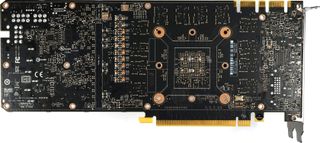
The exposed back of the board reveals two areas on the left that are labeled THERMAL PAD 1 and THERMAL PAD 2. However, these do not actually have any thermal pads on them. We don’t know if Nvidia’s engineers decided that these were unnecessary, or if Nvidia’s accountants decided that they were too expensive, because we can’t present any measurements yet.

The cooler’s massive bottom plate carries the usual thermal pads for the voltage converters and memory modules, as well as several of the thermal fleece strips that we mentioned above. The latter connect additional active elements, such as VR chips, MOSFETs, and diodes, to the bottom plate of the cooler. These are the only changes to the cooling solution that we could discern.
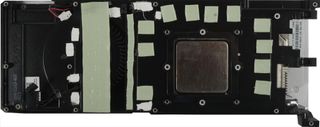
Similar to its previous Founders Edition (FE) graphics cards, Nvidia used a vapor chamber that’s fit into the cooler’s bottom as its main GPU cooler. It’s attached to the board with four spring bolts. Everything else is cooled by connecting to the cooler’s bottom as described above.


Unboxing: Board Design
We took a look at the board and Nvidia’s advertised improvements, as well. The first thing to virtually jump out at even the most casual observer is the fact that Nvidia gave the card a full complement of voltage regulators. Nvidia’s Titan X (Pascal) had the same layout but didn’t have all of the spaces actually occupied. Nvidia has used this same board design since the Quadro P6000. That card's eight-pin power connectors are pointed toward the back, and the eight empty connections for this setup are in plain view, as well.

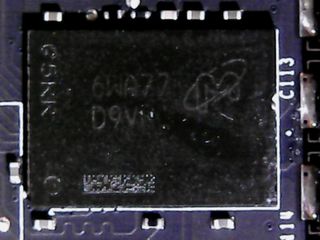
It’s the opposite for the memory modules. Compared to the Nvidia Titan X (Pascal), one memory module’s missing. Only a total of 11 of Micron’s new MT58K256M321-Ja110 GDDR5X memory modules are to be found. They offer up to 11 GB/s, which is meant to compensate for the memory interface’s missing 32 bits with a higher clock frequency of 5,500MHz (effective).
It’s a bit surprising that Nvidia didn’t use Micron’s MT58K256M321-Ja120, which has an even higher clock frequency. The reason might well be that this could have caused thermal problems, since the higher-speed memory operates at 1.35V, but both types of memory are allowed to operate only to a maximum temperature of 95°C.
Nvidia plays it safe with the voltage converters. It's been using the uP9511 for a good long while now. This makes sense, because this PWM controller setup allows for the concurrent operation of seven phases, as opposed to just 6(+2) phases. Also, as usual, the same ones are used for all seven of the GPU’s phases, and they can all be found on the back of the board.


The voltage converters’ design is interesting in that it’s quite simple: One simple buck converter, the LM53603, is responsible for the high side, and two (instead of one) Fairchild D424 n-channel MOSFETs operate on the low side. This setup spreads out the hotspots a bit, because the waste heat is spread across twice the surface area.
For coils, Nvidia went with simple encapsulated ferrite chokes, which are at about the same quality level as Foxconn’s magic coils. They can be installed by machines and aren’t push-through. From a thermal point of view, the back of the board’s a good place for these coils, even though it's puzzling that Nvidia doesn’t cool them, but instead cools only the capacitors that are right next to them.


The memory gets two phases, which are run in parallel by a single uP1685. The high side uses the FD424 mentioned above, whereas the low side sports two dual n-channel Logic Level PowerTrench E6930 MOSFETs in a parallel configuration, which is quite an unusual sight. The coils are smaller due to the two phases being simpler.


Summary and Teaser
So, what’s the verdict on the redesigned cooler? We can’t talk about actual performance numbers yet, but it’s safe to say that it should more aptly be called a cooling reconceptualization. Switching out active components and using additional thermal pads to get rid of waste heat are the readily apparent updates. The cooler itself should be identical from a performance standpoint.
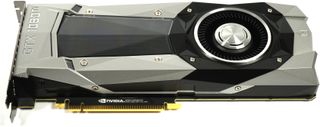
At this point, we have to leave all of the new Nvidia GeForce GTX 1080 Ti’s performance results for a later date. No matter how much we’d like to tell you right now, an NDA’s an NDA. But at least now you have the first piece of the larger story.
-
FormatC Not easy to make such a boring pre-launch more interesting. Make it naked is always working ;)Reply -
t1gran Could you please make clear - why:Reply
Pixel Fill Rate = 140.8 MPix/s
Texel Fill Rate = 358. MTex/s?
According to Base Clock Frequency (1480 MHz) it should be:
88 x 1.480 = 130.24 MPix/s
224 x 1.480 = 331.52 MTex/s
Even with Maximum Clock Frequency (1582 MHz):
88 x 1.582 = 139.22 MPix/s
224 x 1.582 = 354.37 MTex/s
Am I not right? -
falchard What do you think the chances are that nVidia is selling this ahead of Vega because they know they will not sell as many post vega release? After all someone who buys this now won't buy a gpu next month that performs better.Reply
Could also be they expect an uptick in PC sales this month and want to offer a new product to pair with new PC builds. -
FormatC Reply
You 100% right. Nice finding :)19388039 said:Am I not right?
GPU-Z has a bug or better - the driver is reporting wrong numbers. Nvidias drivers said 96 but in real we have 88, the GPU-Z calculation is wrong. Just talked with the guy who made it and he corrected it now.
Good question. But we have a NDA for the 1080 Ti and absolute no info about Vega. This is pure speculation atm.19388162 said:What do you think the chances are that nVidia is selling this ahead of Vega because they know they will not sell as many post vega release? After all someone who buys this now won't buy a gpu next month that performs better.
Could also be they expect an uptick in PC sales this month and want to offer a new product to pair with new PC builds. -
Achaios They are trying to snatch all sales they can taking advantage of AMD's failure to release VEGA.Reply
We know that VEGA will be about 10% faster than the 1080, so even when hi-end VEGA is here, the 1080TI will still be at the top.
1080 TI>Vega Hi-End>1080>Vega Mid Hi-End>1070 -
clonazepam Reply19387933 said:I get it, we're all just big kids unboxing fancy expensive toys.
I took it as more of a shot across the bow to your typical youtuber unboxers/reviewers. Tom's raised the bar (again).
It's too bad the editor in chief probably enjoys handling that role. He's well suited for broadcasting and wouldn't be out of place at all on any major news network as a go-to industry specialist. -
rayden54 Curious: Are any of the pictures of the thermal fleece? It's something I've never heard of before, but when I try to google it, I keep getting clothes (even when I add in the word "computer). I'd like to know what it is.Reply -
FormatC Reply
The problem was again Nvidias salamitactics. Here a thin slice of info, there a few words. I decided to use their NDA for today word by word to unbox it completely. What the hell is unboxing? Grey area. And I'm sure, the editor in chief is a good guy ;)19388282 said:I took it as more of a shot across the bow to your typical youtuber unboxers/reviewers. Tom's raised the bar (again). It's too bad the editor in chief probably enjoys handling that role. He's well suited for broadcasting and wouldn't be out of place at all on any major news network as a go-to industry specialist.
This material is not new but not usual. I have no idea why Nvidia used this different kind of tape. It's like cotton, smashed with thermal grease. Really funny stuff.19388308 said:Curious: Are any of the pictures of the thermal fleece? It's something I've never heard of before, but when I try to google it, I keep getting clothes (even when I add in the word "computer). I'd like to know what it is.
Take a look at the cooler picture, there you will find a lot of this white pieces. The picture is HiRes, you can zoom it.
I doesn't know it and unconfirmed rumors are simply waste of time. 10% faster as what? Founders or oc'ed custom models? This is nothing to believe it. We have to wait. :( I saw (and heard) a Vega engineering sample a few times, but if the PR is showing something, you can be sure, that you see all and nothing. Only what AMD allowed and filtered.19388264 said:We know that VEGA will be about 10% faster than the 1080
Most Popular


